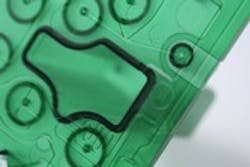Laser welding for microfluidic devices prevents damage
Erlangen, Germany - The significance of microfluidics is growing due to the increasing number of analysis opportunities it opens up (think: "lab-on-a-chip"). The functional zone in a microfluidics device generally consists of two planar surfaces. A lower component has channels created by hot stamping, while an upper cover is placed on top to seal the channel structure. The channels in a microfluidic device are so fine that within it capillary forces dominate and gravitational forces are rendered irrelevant.
Creating a reliable, precise seam between the upper and lower layers is extremely important, and laser welding has established itself as the technology of choice for creating these joints. It is a clean process free of the type of debris, melt blow-out, and additives that can damage a device’s sensitive channels.
At the K show (International Tradefair for Plastics and Rubbers) in Düsseldorf, Germany in October, LPKF will be presenting the new PrecisionWeld laser system designed especially for microfluidic applications. This system can create laser-welded seams with a thickness of 100 microns and has positioning repeatability of 10 microns, a high level of precision that is accomplished by separating the housing from the processing compartment.
With PrecisionWeld, parts can be joined using the classic transmission laser welding technology as well as the new LPKF ClearJoining technology.
In transmission laser welding, the two parts to be joined have different absorption properties, for example, a laser-absorbing basal unit has a clear cover plate. The laser beam passes through the upper transparent layer, but is absorbed when it hits the lower part, so that the energy in the light is converted to heat and melts the plastic. A moderate joining pressure is applied that promotes thermal conduction into the upper part, producing a reliable and precise weld seam.
Because it has a laser wavelength of 1940 nm, the PrecisionWeld is also capable of joining two transparent components using LPKF's ClearJoining technology: At this wavelength, most polymers absorb enough of the light to melt at high-energy densities. The laser beam is focused precisely on the welding horizon to apply the energy where it is required to create a weld, without needing any special additives.
Other features of the PrecisionWeld include a setting that identifies the surface of the component and automatically adjusts the focus to the optimal position. The system is remarkably compact, needs only to be connected to a power supply and a compressed air line for operation, and is small enough to be equipped with rollers.
